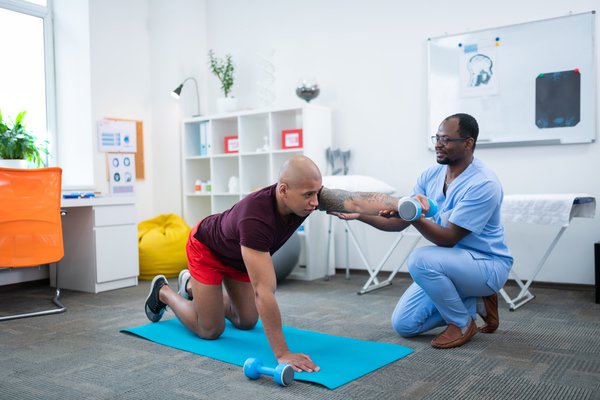If you recently suffered an injury or are experiencing difficulty with movement, your doctor may recommend physical therapy. Physical therapy is a form of rehabilitation that can help decrease pain and improve mobility. It’s a different type of treatment than you may be used to, so if you need physical therapy, here’s what you can expect.
Your physical therapist
You will receive treatment from a physical therapist (PT), a health care professional who can help you build strength and gain skills related to movement. PTs are licensed and may specialize in one of many different practice areas relevant to your needs, ranging from pediatrics to orthopedics to sports. If you haven’t received a referral to a specific PT, you can find one in a hospital, private practice, or in dedicated rehab facilities.
The first visit
Every PT visit has three basic components: assessment, diagnosis, and treatment. Your first visit will be heavier on assessment and diagnosis than treatment. Expect to answer a variety of questions about the pain you’re experiencing and your health history before you engage in activity with the PT, including testing strength, balance, and mobility. Early PT visits can be hard as your body adapts to the treatment, but over time, visits will become easier.
- MORE ON HEALTH & WELLNESS
- How to combat insomnia with the Constructive Worry method
- A guide to understanding each stage of sleep
- A psychologist’s take on the healing power of listening
Your treatment plan
Once your PT has assessed your needs, they will build a treatment plan specific to your diagnosis. The most important element will be exercise, which can range from basic activities to more complicated ones assisted by the PT. You will probably receive additional exercises to do at home between sessions; if you’re starting physical therapy, plan on doing this “homework” so you can heal faster.
How to prepare
Wear loose-fitting, athletic, or other clothes to your physical therapy sessions that will be easy to move around in, along with good athletic shoes with support. You should also give some thought to your goals for treatment, and be open to additional rehabilitation treatments, including hot or cold therapy, massage, or other approaches that may be part of your treatment plan.
Benefits of physical therapy
If you need physical therapy but are on the fence about doing it, you should know there are some important benefits beyond reduced pain and increased motion. In fact, physical therapy may help you avoid both prescription opioids (for managing pain) and in some cases even surgery for injuries such as a torn rotator cuff or torn meniscus.
People participate in physical therapy for various timelines, so you
should be prepared to work with your PT for some time. Go into your
physical therapy treatment course open-minded, and committed to putting
in the work that will be asked of you, and you’ll be delighted with the
improvement in how you feel.



